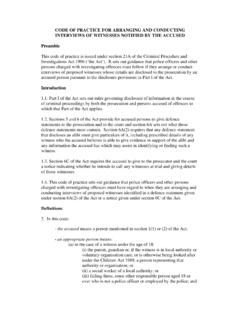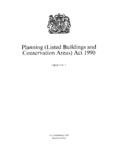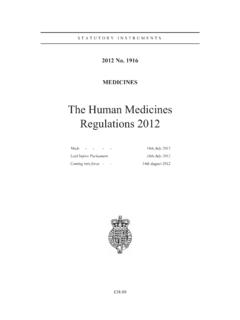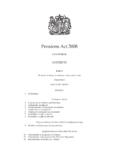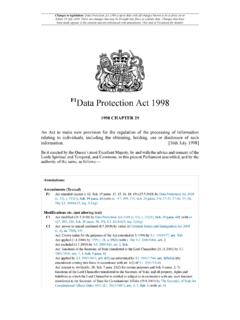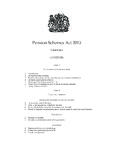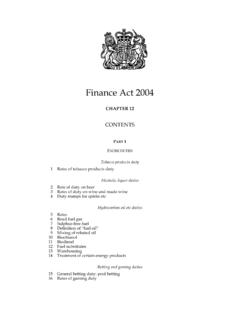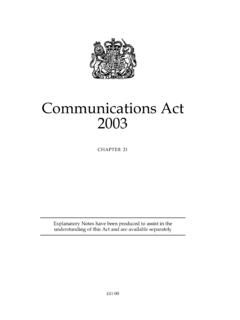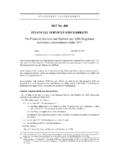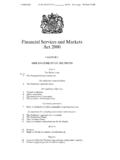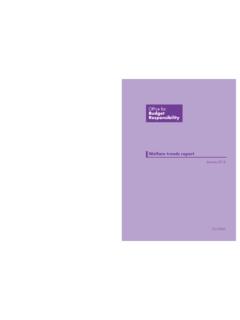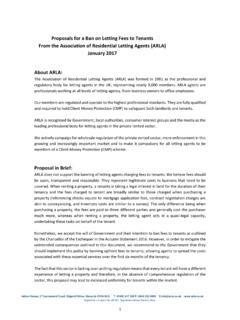Transcription of The Loans for Mortgage Interest Regulations 2017
1 TNA/ 1 EXPLANATORY MEMORANDUM TO THE Loans FOR Mortgage Interest Regulations 2017 2017 No. 725 1. Introduction This explanatory memorandum has been prepared by the Department for Work and Pensions and is laid before Parliament by Command of Her Majesty. 2. Purpose of the instrument The purpose of this instrument is to enable help to be provided to benefit claimants who are homeowners in respect of their liability to make owner-occupier payments (principally Mortgage Interest ) in the form of Interest -bearing loan payments. This is in consequence of powers in the Welfare Reform and Work Act 2016 ( the 2016 Act ). This instrument also makes consequential amendments to other Regulations to end the current provision of help with owner-occupier payments (commonly known as Support for Mortgage Interest ( SMI )) which is paid as part of a claimant s benefit award, and sets out certain transitional arrangements.
2 3. Matters of special Interest to Parliament Matters of special Interest to the Joint Committee on Statutory Instruments None. Other matters of Interest to the House of Commons As this instrument is subject to negative resolution procedure, consideration as to whether there are other matters of Interest to the House of Commons does not arise at this stage. 4. Legislative Context Help with owner-occupier payments is currently included in a claimant s award of Income Support, income-based Jobseeker s Allowance, income-related Employment and Support Allowance, State Pension Credit or Universal Credit under the Income Support ( Regulations ) 19871, Jobseeker s Allowance Regulations 19962, Employment and Support Allowance Regulations 20083, State Pension Credit Regulations 20024 and the Universal Credit Regulations 20135.
3 In addition, owner-occupier claimants who are leaseholders may get help with a limited range of other housing costs, including certain service charges and ground rent. The 2016 Act enables Regulations to be made which provide for help with owner-occupier payments to be made as Loans rather than as part of a claimant s benefit award, and for the detailed framework of the scheme to be set out in Regulations . Help 1 Income Support (General) Regulations 1987 2 Jobseeker's Allowance Regulations 1996 3 Employment and Support Allowance Regulations 2008 4 State Pension Credit Regulations 2002 5 Universal Credit Regulations 2013 TNA/ 2with other housing costs (such as service charge and ground rent) will continue to be made via the income-related benefit schemes.
4 Changing this help from a benefit into a loan is intended to ensure that owner-occupier claimants continue to be protected from the risk of having their homes repossessed whilst providing increased fairness to taxpayers, many of whom cannot afford to buy a home of their own. 5. Extent and Territorial Application The extent of this instrument is Great Britain. The territorial application of this instrument is Great Britain. Northern Ireland will make legislation in line with this instrument. 6. European Convention on Human Rights As the instrument is subject to negative resolution procedure and does not amend primary legislation no statement is required.
5 7. Policy background Background The prime objective of SMI is to provide short-term help to prevent repossession by making a contribution towards owner-occupier payments (principally Mortgage Interest payments) while claimants take steps to move back into work. The housing market has changed significantly since SMI was introduced in 1948. The upward trend in real house prices means that many owners have accrued significant equity in their homes. The result is that claimants who have capital assets in the form of their homes can still access financial assistance from the taxpayer in the form of a benefit, with no mechanism in place to recoup any of the funds provided to them.
6 This means that in many cases taxpayers are effectively funding the accumulation of a potentially valuable capital asset. In 1948, it was very unusual for people to take mortgages into retirement. However, now almost half of SMI recipients are pensioners, many of whom are likely to receive SMI for significant periods into their retirement. In many of these cases the equity that has been secured at taxpayers expense passes on to the claimant s heirs after their death. Based on the 2014-15 Family Resources Survey, in Great Britain million households are owner-occupiers. Of these million owned outright and million were paying off a Mortgage .
7 Half (49%) of Mortgage holders, based on the lead respondent, are between 35 and 54 years, a third (34%) are younger than 35 and 16 per cent are 65 or over. Less than 1 in 20 Mortgage holders (4%) are 65 or over. The large majority (82%) of mortgagors include an adult in full time employment. Currently, there are an estimated 124,000 claimants receiving SMI at a cost to the Exchequer of 170 million per annum (DWP Expenditure and Caseload Forecasts: Autumn Statement 2016). Around 48% are working age and 52% pension age. The cost of SMI is sensitive to increases in Mortgage Interest rates, for example if the standard Interest rate of (which will apply from 18 June 2017 onwards) were TNA/ 3doubled to at the current caseload the additional cost of SMI to the exchequer would be in the region of 170m a year.
8 Annual house price growth has been positive since May 2012 and has been above 5% per year since December 2013. It is forecast by the Office for Budget Responsibility to be between and until 2022. This, together with the effects of more people taking their mortgages into retirement, means that Support for Mortgage Interest (SMI) could become far more expensive in the future. Policy change In the Summer Budget 2015, the Chancellor announced that from April 2018 SMI would be changed from a benefit to an Interest -bearing loan . The powers to establish this change are set out in the 2016 Act. The Government expects to recover the vast majority of Loans made to claimants (referred to as a series of loan payments in the Regulations ), although in some cases this may not be possible, such as where claimants are in arrears with their Mortgage or the value of the house has fallen since the Mortgage was taken out.
9 For planning purposes, the assumption is that around 9% of debt will be written off. This is based on an analysis of a sample of data provided by the Council of Mortgage Lenders. Under the Regulations , eligibility for the loan payments remains the same as for SMI as a benefit which means that owner-occupiers who are entitled to one of the income-related benefits (Income Support, Jobseeker s Allowance, Employment and Support Allowance, Universal Credit or Pension Credit) and need assistance with meeting their owner-occupier payments will be offered loan payments. With the removal of SMI as part of their benefit entitlement, some individuals will no longer be entitled to one of the income-related benefits because they have too much income.
10 The Regulations ensure that this group will be treated as entitled to one of those benefits to ensure that they remain eligible for SMI and they will be offered SMI Loans . They will however lose entitlement to some pass-ported benefits where the sole qualifying criterion is receipt of one of the income-related benefits. We believe that the number of people affected will be very low. These claimants may still be able to get help via certain pass-ported benefit schemes where there is an alternative access route via a low income test. The loan payments will be available for the same owner-occupier payments as under the current scheme.
